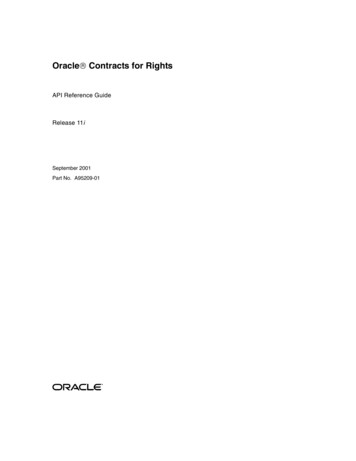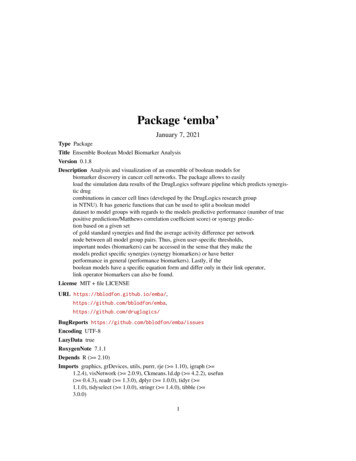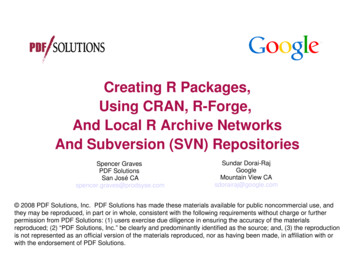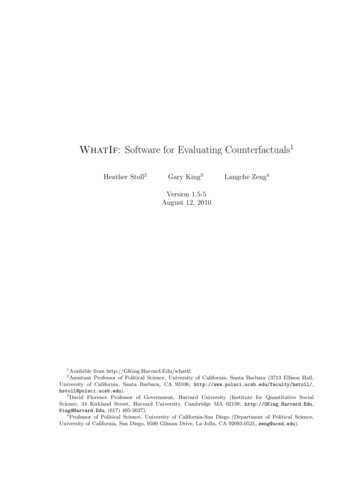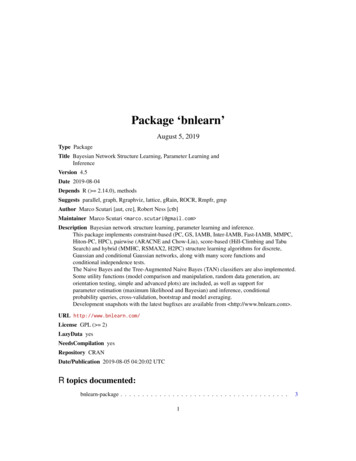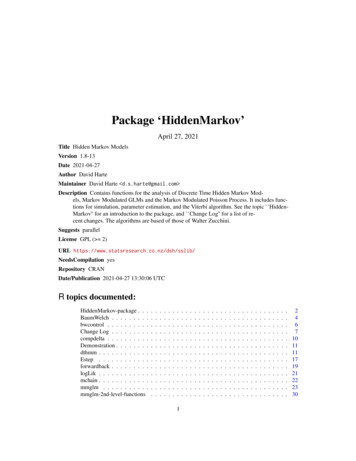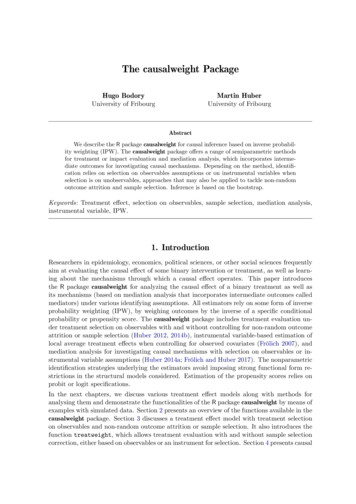
Transcription
The causalweight PackageHugo BodoryMartin HuberUniversity of FribourgUniversity of FribourgAbstractWe describe the R package causalweight for causal inference based on inverse probability weighting (IPW). The causalweight package offers a range of semiparametric methodsfor treatment or impact evaluation and mediation analysis, which incorporates intermediate outcomes for investigating causal mechanisms. Depending on the method, identification relies on selection on observables assumptions or on instrumental variables whenselection is on unobservables, approaches that may also be applied to tackle non-randomoutcome attrition and sample selection. Inference is based on the bootstrap.Keywords: Treatment effect, selection on observables, sample selection, mediation analysis,instrumental variable, IPW.1. IntroductionResearchers in epidemiology, economics, political sciences, or other social sciences frequentlyaim at evaluating the causal effect of some binary intervention or treatment, as well as learning about the mechanisms through which a causal effect operates. This paper introducesthe R package causalweight for analyzing the causal effect of a binary treatment as well asits mechanisms (based on mediation analysis that incorporates intermediate outcomes calledmediators) under various identifying assumptions. All estimators rely on some form of inverseprobability weighting (IPW), by weighing outcomes by the inverse of a specific conditionalprobability or propensity score. The causalweight package includes treatment evaluation under treatment selection on observables with and without controlling for non-random outcomeattrition or sample selection (Huber 2012, 2014b), instrumental variable-based estimation oflocal average treatment effects when controlling for observed covariates (Frölich 2007), andmediation analysis for investigating causal mechanisms with selection on observables or instrumental variable assumptions (Huber 2014a; Frölich and Huber 2017). The nonparametricidentification strategies underlying the estimators avoid imposing strong functional form restrictions in the structural models considered. Estimation of the propensity scores relies onprobit or logit specifications.In the next chapters, we discuss various treatment effect models along with methods foranalysing them and demonstrate the functionalities of the R package causalweight by means ofexamples with simulated data. Section 2 presents an overview of the functions available in thecausalweight package. Section 3 discusses a treatment effect model with treatment selectionon observables and non-random outcome attrition or sample selection. It also introduces thefunction treatweight, which allows treatment evaluation with and without sample selectioncorrection, either based on observables or an instrument for selection. Section 4 presents causal
2The causalweight Packagemediation models based on selection on observables assumptions along with the medweightfunction for estimating causal mechanisms. Section 5 discusses treatment effect evaluationbased on an instrument when controlling for observed covariates and its implementation inthe lateweight function. Section 6 considers mediation analysis with distinct instrumentsfor the treatment and the mediator when controlling for observed covariates, as implementedin the medlateweight function. Section 7 concludes.2. Overview of the causalweight packageThe causalweight package consists of four functions aimed at user-friendly treatment evaluation and mediation analysis. The following table illustrates the structure of the causalweight package by assigning to each of the main functions the corresponding treatment effect/mediation model.Functions in RtreatweightmedweightlateweightmedlateweightTable 1: Main functions of the causalweight packageTreatment effect modelsTreatment evaluation with or without sample selection correction (Section 3).Causal mediation analysis (Section 4).Local average treatment effect with covariates (Section 5).Causal mediation analysis with instrumental variables (Section 6).The function treatweight implements treatment evaluation under treatment selection on observables, optionally with correcting for sample selection or non-ignorable outcome attritionbased on either a selection on observables/missing at random assumption or an instrument. Totackle the double selection problem into the treatment and into the subpopulation with nonmissing outcomes, it makes use of both treatment and selection propensity scores to appropriately reweigh observations by IPW, see Huber (2012, 2014b). The function treatweightallows computing the average treatment effect in the total population (ATE) and on thetreated (ATET).The function medweight implements mediation analysis to investigate the causal mechanismsof a binary treatment under selection on observables based on IPW. More specifically, itcomputes (i) the (total) average treatment effect, (ii) the average natural indirect effect,which operates through an intermediate outcome (or mediator) situated on the causal pathbetween the treatment and the outcome, and (iii) the (unmediated) average natural directeffect, see Huber (2014a). The indirect and direct effect estimates are returned under eitherpotential treatment state. The function treatweight allows computing the effects for boththe total population and the subpopulation of the treated.The function lateweight returns the local average treatment effect (LATE) of a binary endogenous treatment based on IPW using a binary endogenous instrument that is conditionallyvalid given observed covariates, see Frölich (2007). In addition, it returns the intention-totreat effect of the instrument on the outcome, as well as first-stage effect of the instrumenton the treatment. The function lateweight permits estimating the local average treatmenteffect among all subjects whose treatment complies with the instrument (LATE) and amongtreated compliers (LATTs) by weighing units by the inverse of their instrument propensityscores.
Hugo Bodory, Martin Huber3The function medlateweight computes the causal mechanisms (natural direct and indirecteffects) of a binary treatment among treatment compliers based on distinct instrumental variables (IVs) for the treatment and the mediator, which are assumed to be conditionally validgiven a set of observed covariates. The treatment and its instrument are assumed to be binary while the mediator and its instrument are assumed to be continuous. This motivatescombining the LATE approach with a control function approach for tackling mediator endogeneity, see Theorem 1 in Frölich and Huber (2017). The function medlateweight yields(i) the (total) local average treatment effect (LATE) among compliers based on IPW, (ii)the average natural direct and indirect effects under either potential treatment state amongcompliers based on IPW, and (iii) parametric direct and indirect effect estimates (imposingeffect homogeneity across treatment states) based on regression.Details on the models and the implementation of the corresponding estimators in the causalweight package are provided in the following Sections 3 to 6.3. Treatment evaluation with sample selection correctionThe function treatweight implements treatment effect evaluation when the treatment selection is related to observed covariates, optionally with considering sample selection/nonrandom outcome attrition. The latter case constitutes a double selection problem (i) into thetreatment (selection on observables) and (ii) into the subpopulation for which the outcomeis observed (selection on unobservables). The function treatweight computes the averagetreatment effect (ATE) and the average treatment effect on the treated (ATET) by weighing observations by the inverse of (nested) propensity scores. The nested weights control fortreatment selection bias due to non-random treatment assignment and sample selection biasin the subpopulation with observed outcomes, see Huber (2012, 2014b).3.1. ModelWhen estimating the causal effect of a binary treatment D on an outcome Y , researchersare typically confronted with the identification issue that take-up of D is selective. As afurther complication, Y might only be observed for a subpopulation that is non-randomlyselected, as indicated by a binary sample selection variable S. We tackle the former issue byassuming treatment selection on observed covariates X and the latter issue by either assumingignorability of sample selection given observables, or the availability of an instrument Z thatis conditionally valid.We consider a general model, in which outcome Y is an unknown function of two observedcomponents, the binary treatment D and the vector of covariates X, and a possibly multidimensional unobserved term U :Y ϕ(D, X, U ),(1)where ϕ(·) is an unknown function.While D and X are assumed to be observed for everyone, the treatweight function permit forsample selection, implying that outcome Y is only observed for a subpopulation as indicated bythe binary selection indicator S. Empirical examples for such set-ups include wage equations(where S is employment), see Gronau (1974) and Heckman (1976, 1974), the evaluation of
4The causalweight Packageeffects of educational interventions on test scores (where S is participation in the test), seeAngrist, Bettinger, and Kremer (2006) and Angrist, Lang, and Oreopoulos (2009), or loss ofoutcome follow-up in repeated surveys. In our model, the selection indicator is either assumedto be a function of the treatment, the covariates, and an unobserved term, or of the previouslymentioned terms and an instrument:S I{η(D, X) V } (scenario 1),(2)S I{ζ(D, X, Z) V } (scenario 2).(3)I{·} denotes the indicator function and η(·), ζ(·) are unknown functions. Z represents a oneor multi-dimensional instrument which is observable for all units and not directly related withthe outcome. V is an unobserved term. If it is not associated with U , sample selection isrelated to observables or missing at random (MAR) in the denomination of Rubin (1976).If V is associated with U , S is endogenous even when controlling for (D, X). In this case,identification crucially hinges on the availability of an instrument Z that is relevant for S inthe sense that it shifts the selection probability conditional on (D, X) but does not appear inϕ (exclusion restriction), as in scenario 2 of (2). In general, at least one element in Z needsto be continuous.To define the causal effect of D, we utilize the potential outcome framework advocated byRubin (1974), among others. We denote the potential outcome for individual i and somehypothetical treatment D d asYi (d) ϕ(d, Xi , Ui ).(4)The difference Yi (1) Yi (0) would yield the individual treatment effect, but is unknown tothe researcher, because each individual is either treated or not treated and cannot appear inboth states of the world at the same time. The average treatment effect (ATE), which can beidentified under assumptions outlined in the following section, is given by the mean differenceof the potential outcomes under treatment and non-treatment: E[Y (1)] E[Y (0)].(5)A further parameter of policy interest, is the mean effect among those receiving the treatment,the average treatment effect on the treated (ATET): D 1 E[Y (1) D 1] E[Y (0) D 1].(6)3.2. IdentificationIn the absence of sample selection, the ATE is identified if Y (1), Y (0) are independent ofD conditional on X (selection on observables) and the treatment propensity score π(X) Pr(D 1 X) is larger than zero and smaller than 1 almost surely (common support), seeImbens and Wooldridge (2009). The ATE then corresponds to the following expression basedon weighing by the inverse of the propensity score: D·Y(1 D) · Y E E.(7)π(X)1 π(X)
Hugo Bodory, Martin Huber5The idea of inverse probability weighting (IPW) goes back to Horvitz and Thompson (1952),who first proposed an estimator of the population mean in the presence of non-randomly missing data. The ATET is obtained by multiplying the expressions in the expectation operatorsof (7) by π(X)/ Pr(D 1), see Hirano, Imbens, and Ridder (2003), which corresponds to: D·Y(1 D) · Y · π(X) D 1 E E.(8)Pr(D 1)(1 π(X)) · Pr(D 1)The ATET is identified under the assumptions that Y (0) is independent of D conditional onX and π(X) is smaller than 1 almost surely.Complications prevail if the outcomes are observed for a selective subpopulation only, whichrequires further assumptions for identification. One possible condition is that sample selectionS is driven by observable variables but independent of Y conditional on (D, X), i.e. MAR (seescenario 1 in (2)). When adding this assumption to the previous ones, the ATE is identified byreweighing observations (additionally to the inverse treatment propensity score) by the inverseof the sample selection propensity score p(D, X) Pr(S 1 D, X), see Huber (2012): S·D·YS · (1 D) · Y E E,(9)p(D, X) · π(X)p(D, X) · (1 π(X))which hinges on p(D, X) being larger than 0 almost everywhere as additional common supportrestriction.Alternatively to assuming MAR, sample selection might be tackled by an instrumental variablestrategy, see see scenario 2 in (2). In this context, is identified under the following assumptions, see Huber (2014b): (i) satisfaction of the selection on observables assumption in thetotal population as before, (ii) availability of an instrument for selection that satisfies the exclusion restriction such that the sample selection propensity score Pr(S 1 D, X, Z) is a validcontrol function, (iii) independence of (U, V ) and (D, Z) conditional on Pr(S 1 D, X, Z)and X, and (iv) homogeneity of average treatment effects conditional on X. The ATE on thetotal population under sample selection is identified by weighing by the inverse of a nestedtreatment propensity score as well as the selection propensity score, given that specific common support conditions on the propensity scores hold: S·D·YS · (1 D) · Y E E.(10)p(W ) · π(X, p(W ))p(W ) · (1 π(X, p(W )))π(X, p(W )) denotes the treatment propensity score Pr(D 1 X, p(W )), i.e., the probabilityof being treated conditional on X and p(W ), with W (D, X, Z) and p(W ) Pr(S 1 D, X, Z). Analogously to (8), multiplying the expressions in the expectation operators of(9) and (10) by π(X)/ Pr(D 1) yields the ATET under the respective set of assumptions.3.3. EstimationAssuming an i.i.d. sample of n units prior to selection, indexed by i 1, ., n, we brieflydiscuss the estimation of the ATE under sample selection using an instrument based on thenormalized sample analog of (10). Estimation of treatment effects under different sets of assumptions (i.e. MAR or no sample selection) proceeds analogously. Let p̂(W ) and π̂(X, p̂(W ))denote estimates of the sample selection propensity score p(W ) and the treatment propensity
6The causalweight Packagescore π(X, p(W )), respectively. A general 3-step estimation approach proceeds as follows:(a) Estimate p̂(W ) by regressing S on (1, D, X, Z),(b) estimate π̂(X, p̂(W )) by regressing D on (1, X, p̂(W )),ˆ as the normalized sample analogue of (10)(c) obtain an estimate of the ATE, denoted by ,in which p̂(W ) and π̂(X, p̂(W )) are used as plug-in estimates.The propensity scores are estimated by probit or logit models. The normalized sample analogue of (10) corresponds toXnnXSi · Di · YiS i · Diπ̂(Xi , p̂(Wi ))π̂(Xi , p̂(Wi ))i 1i 1XnnXSi · (1 Di )Si · (1 Di ) · Yi .p̂(Wj ) · (1 π̂(Xi , p̂(Wi )))p̂(Wj ) · (1 π̂(Xi , p̂(Wi )))ˆ i 1(11)i 1PPnSi ·(1 Di )·DiThe normalizations ni 1 π̂(XSii,p̂(Wandi 1 p̂(Wj )·(1 π̂(Xi ,p̂(Wi ))) ensure that the weights in))ieach treatment group add up to unity. This may improve the finite sample properties ofthe estimator, see for instance the discussions in Imbens (2004) and Busso, DiNardo, andMcCrary (2014).This and other semiparametric IPW estimators discussed further below can be expressed assequential GMM estimators where parametric propensity score estimation represents the firststep and effect estimation the second step, see Newey (1984). It follows from his results that our methods are n-consistent and asymptotically normal under standard regularityconditions. Therefore, the i.i.d. bootstrap is a valid inference method for treatment effectestimators based on IPW, see also Hirano et al. (2003). The function treatweight allowsspecifying the number of bootstrap replications for computing standard errors. Furthermore,it offers a trimming rule for discarding observations with extreme propensity scores to improveoverlap, see Crump, Hotz, Imbens, and Mitnik (2009). The default is to discard observationswith treatment propensity scores smaller than 0.05 (5%) or larger than 0.95 (95%), whenconsidering the ATE or larger than 0.95 when considering the ATET. When a sample selectioncorrection is included, the default is to discard observations with sample selection propensityscores smaller than 0.05.3.4. Examples in RThis section presents (i) the input arguments of the treatweight function, (ii) the outputstored in the object generated by treatweight, and (iii) two examples for ATE estimationwith and without sample selection, respectively.Input arguments of treatweightThe input arguments of treatweight are:
Hugo Bodory, Martin Huber7Table 2: Input arguments of the treatweight res of the variablesDependent variable.Treatment, must be binary (either 1 or 0), must not contain missings.Confounders of the treatment and outcome, must not contain missings.Selection indicator. Must be 1 if y is observed (non-missing) and 0 if y isnot observed (missing). Default is NULL, implying that y does not containany missings.Optional instrumental variable(s) for selection s. If NULL, outcome selectionbased on observables (x,d) - known as ”missing at random” - is assumed.If z is defined, outcome selection based on unobservables - known as ”nonignorable missingness” - is assumed. Default is NULL. If s is NULL, z isignored.Only to be used if both s and z are defined. If TRUE, the effect is estimatedfor the selected subpopulation with s 1 only. If FALSE, the effect is estimated for the total population (note that this relies on somewhat strongerstatistical assumptions). Default is FALSE. If s or z is NULL, selpop isignored.If FALSE, the average treatment effect (ATE) is estimated. If TRUE, theaverage treatment effect on the treated (ATET) is estimated. Default isFALSE.Trimming rule for discarding observations with extreme propensity scores.If ATET FALSE, observations with Pr(D 1 X) trim or Pr(D 1 X) (1 trim) are dropped. If ATET TRUE, only those observations withPr(D 1 X) (1 trim) are dropped. If s is defined and z is NULL, observations with extremely low selection propensity scores, Pr(S 1 D, X) trim, are discarded, too. If s and z are defined, the treatment propensityscores to be trimmed change to Pr(D 1 X, Pr(S 1 D, X, Z)). If inaddition selpop TRUE, observation with Pr(S 1 D, X, Z) trim arediscarded, too. Default for trim is 0.05.If FALSE, probit regression is used for propensity score estimation. If TRUE,logit regression is used. Default is FALSE.Number of bootstrap replications for estimating standard errors. Defaultis 1999.The treatweight objectA treatweight object contains six components all of which can be referenced by a dollar sign( ), see the examples in this section below. These components are:
8The causalweight PackageTable 3: Components of the treatweight n of the componentsAverage treatment effect (ATE) if ATET FALSE or the average treatmenteffect on the treated (ATET) if ATET TRUE.bootstrap-based standard error of the effect.p-value of the effect.mean potential outcome under treatment.mean potential outcome under control.number of discarded (trimmed) observations due to extreme propensityscore values.Example for estimating the ATE without sample selectionThis example estimates the ATE based on equation (7) in simulated data. The sample sizen is set to 10’000. The seeds set when generating random variables (set.seed()) enable thereplication of the results. The following chunk of R input code results in the output of thefunction treatweight: n 10000set.seed(100); x rnorm(n)set.seed(101); d (0.25*x rnorm(n) 0)*1set.seed(102); y 0.5*d 0.25*x rnorm(n)output treatweight(y y,d d,x x,trim 0.05,ATET FALSE,logit TRUE, boot 19)cat("ATE: ",round(c(output effect),3),", standard error: ",round(c(output se),3), ", p-value: ",round(c(output pval),3))output ntrimmedThe following chunk of output code displays two lines (based on the treatweight object calledoutput). The first line gives the ATE estimate, standard error, and p-value, respectively(rounded to three decimals). The second line provides the number of observations discardedby the trimming rule.ATE:0.488 , standard error:0.022 , p-value:0[1] 0Example for estimating the ATE under sample selection based on an instrumentThis example estimates the ATE under sample selection based on equation (10) in simulateddata. The sample size n is set to 10’000. Matrix e reflects the unobserved terms of equations(1) and (2) for computing y and s and follows a multivariate normal distribution with covariance matrix sigma. The following chunk of R input code results in the output of the functiontreatweight:
Hugo Bodory, Martin Huber 9n 10000sigma matrix(c(1,0.6,0.6,1),2,2)set.seed(100); e (2*rmvnorm(n,rep(0,2),sigma))set.seed(101); x rnorm(n)set.seed(102); d (0.5*x rnorm(n) 0)*1set.seed(103); z rnorm(n)s (0.25*x 0.25*d 0.5*z e[,1] 0)*1y d x e[,2]; y[s 0] 0output treatweight(y y,d d,x x, s s,z z,selpop FALSE,trim 0.05,ATET FALSE,logit TRUE,boot 19)cat("ATE: ",round(c(output effect),3),", standard error: ",round(c(output se),3), ", p-value: ",round(c(output pval),3))output ntrimmedThe first line of the next chunk of output code (again based on the treatweight objectcalled output) provides the ATE under sample selection, the standard error, and the p-value,respectively (rounded to three decimals). The second line gives the number of observationsdiscarded by the trimming rule.ATE:0.966 , standard error:0.073 , p-value:0[1] 114. Causal mediation analysisThe function medweight estimates the causal mechanisms of a binary treatment under selection on observables, based on inverse probability weighting. More specifically, it provides (i)the (total) average treatment effect, (ii) the average natural indirect effect of the treatmentoperating through an intermediate variable (or mediator) that is situated on the causal pathbetween the treatment and the outcome, and (iii) the natural direct effect, see Huber (2014a).The indirect and direct effect estimates are returned under either potential treatment state.The evaluation of direct and indirect effects is commonly referred to as mediation analysis.The function treatweight performs causal mediation analysis both for the total populationas well as the subpopulation of the treated.4.1. ModelIn many evaluations not only the (total) treatment effect appears relevant, but also the causalmechanisms through which it operates. In this case, one would like to disentangle the directeffect of the treatment on the outcome as well as the indirect ones that materialize throughone or more intermediate variables, so-called mediators. For instance, when assessing the employment effects of an active labor market policy, policy makers might want to know to whichextent the total impact comes from increased search effort, human capital, or other mediatorsthat are themselves affected by the policy. However, even experiments do not straightforwardly identify causal mechanisms. As discussed in Robins and Greenland (1992), randomtreatment assignment does not imply exogeneity of the mediator. Therefore, the total effect
10The causalweight Packagecannot be disentangled by simply conditioning on a mediator, because this generally introduces selection bias coming from variables influencing both the mediator and the outcome,see Rosenbaum (1984).For defining the parameters of interest, the potential outcome framework is used, which hasbeen considered in the direct and indirect effects framework for instance by Rubin (2004)and Albert (2008). Let Y (d), M (d) denote the potential outcome and the potential mediatorstate under treatment d {0, 1}. For each unit only one of the two potential outcomes andmediator states, respectively, is observed, because the realized outcome and mediator valuesare Y D · Y (1) (1 D) · Y (0) and M D · M (1) (1 D) · M (0).The ATE is defined by E[Y (1) Y (0)]. To disentangle this total effect into a direct andindirect (through M ) causal channel, first note that the potential outcome can be rewrittenas a function of both the treatment and the intermediate variable M : Y (d) Y (d, M (d)). Itfollows that the (average) direct effect is identified byθ(d) E[Y (1, M (d)) Y (0, M (d))],d {0, 1},(12)i.e., by exogenously varying the treatment but keeping the mediator fixed at its potentialvalue for D d. Equivalently, the (average) indirect effects is defined asδ(d) E[Y (d, M (1)) Y (d, M (0))],d {0, 1},(13)i.e., by exogenously shifting the mediator to its potential values under treatment and nontreatment but keeping the treatment fixed at D d. Pearl (2001) refers to these parametersas natural direct and indirect effects, Robins and Greenland (1992) and Robins (2003) as totalor pure direct and indirect effects.The ATE is the sum of the direct and indirect effects defined upon opposite treatment states: E[Y (1, M (1)) Y (0, M (0))] E[Y (1, M (1)) Y (0, M (1))] E[Y (0, M (1)) Y (0, M (0))] θ(1) δ(0) E[Y (1, M (0)) Y (0, M (0))] E[Y (1, M (1)) Y (1, M (0))] θ(0) δ(1). (14)This can be seen from adding and subtracting E[Y (0, M (1))] after the first and E[Y (1, M (0))]after the third equality. The notation θ(1), θ(0) and δ(1), δ(0) indicates that effects are potentially heterogeneous w.r.t. potential treatment state, which permits interaction effects betweenthe treatment and the mediator. However, the effect remain unidentified without further assumptions, as either Y (1, M (1)) or Y (0, M (0)) is observed for any unit, whereas Y (1, M (0))and Y (0, M (1)) are never observed. Therefore, identification of direct and indirect effectshinges on the existence of exogenous variation in the treatment and the mediator.4.2. IdentificationWe subsequently discuss the identification of natural direct and indirect effects based oncontrol variables (for tackling selection into D and M ) that are either not affected by thetreatment (Section 4.2.1) or partly a function of the treatment (Section 4.2.2).Identification given control variables not affected by the treatment
Hugo Bodory, Martin Huber11The identification of direct and indirect effects hinges on selection on observables assumptions w.r.t. D and M , see for instance Imai, Keele, and Yamamoto (2010). They imply thatthe treatment-mediator and treatment-outcome relations are unconfounded by unobservableswhen controlling for observed covariates X and that the mediator-outcome relation is unconfounded given (D, X). Formally, D must be independent of the potential outcomes andmediators, {Y (d0 , m), M (d)}, given X, while M must be Y (d, m) independent of given (D, X),with d0 , d {0, 1} and m in the support of M . Importantly, X must not be affected by D,which is satisfied if both the controls for the treatment and the mediator are pre-treatmentvariables. Furthermore, a specific common support assumption must hold which guaranteesthat comparable observations in terms of X and in terms of both X and D exist acrosstreatment states and across mediator states, respectively. Formally, the treatment propensityscore Pr(D 1 M, X) must be larger than zero and smaller than one almost surely.Huber (2014a) shows that under these assumptions, the average direct effect is identified by Y ·DPr(D d M, X)Y · (1 D)θ(d) E·. (15) Pr(D 1 M, X) 1 Pr(D 1 M, X)Pr(D d X)Equation (15) demonstrates that by IPW, the distributions of both M and X are balancedacross treated and non-treated groups such that the direct effect is identified. In particular,the distribution of the mediator in both groups corresponds to that of M (d) in the totalpopulation. Similarly, the indirect effect, which by (14) corresponds to the difference betweenthe average and the direct effect defined on the opposite treatment state (δ(d) θ(1 d))is given by Y · I{D d}Pr(D 1 M, X) 1 Pr(D 1 M, X)δ(d) E· . (16)Pr(D d M, X)Pr(D 1 X)1 Pr(D 1 X)An attractive feature of expressions (15) and (16) is that they are agnostic about the dimension of M such that both scalar or vectors of mediators can be considered. In eithercase, identification relies on reweighing by the treatment propensity scores Pr(D 1 M, X)and Pr(D 1 X), which makes estimation straightforward even when M is multidimensional.Multiplying the expressions in the expectation operators of (15) and (16) by π(X)/ Pr(D 1)yields the direct and indirect effects, respectively, on the treated.Identification when some controls are affected by the treatmentWe maintain that X reflects control variables not affected by the treatment but now permitthat D has an effect on observed post-treatment confounders of the mediator-outcome relation,which we denote by W . This appears particularly important in applications with a nonnegligible time lag between D and M such that X may be insufficient to control for selectioninto the mediator. We rewrite the potential mediator and potential outcome as functions ofW , too: M (d) M (d, W (d)) and Y (d, M (d)) Y (d, M (d, W (d)), W (d)), where W (d) is thevector of potential values of W for D d.Treatment assi
weight package by assigning to each of the main functions the corresponding treatment ef-fect/mediation model. Table 1: Main functions of the causalweight package Functions in R Treatment e ect models treatweight Treatment evaluation with or without sample selection correction (Sec-tion3). medweight Causal mediation analysis (Section4).


